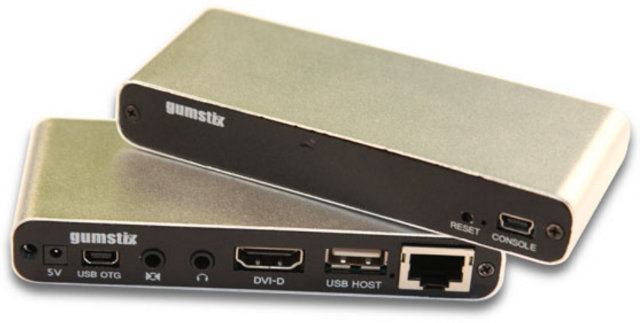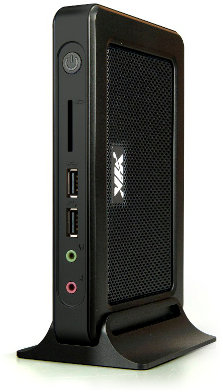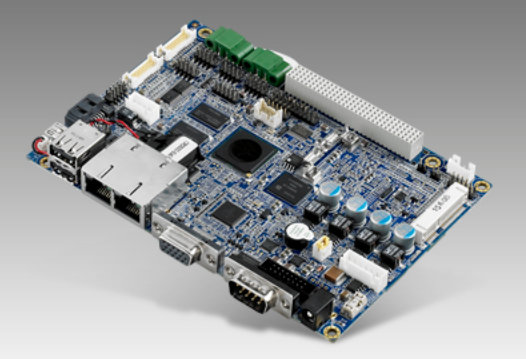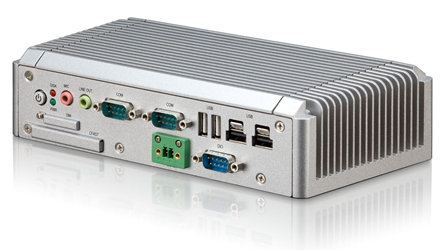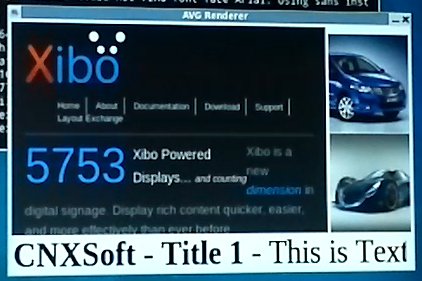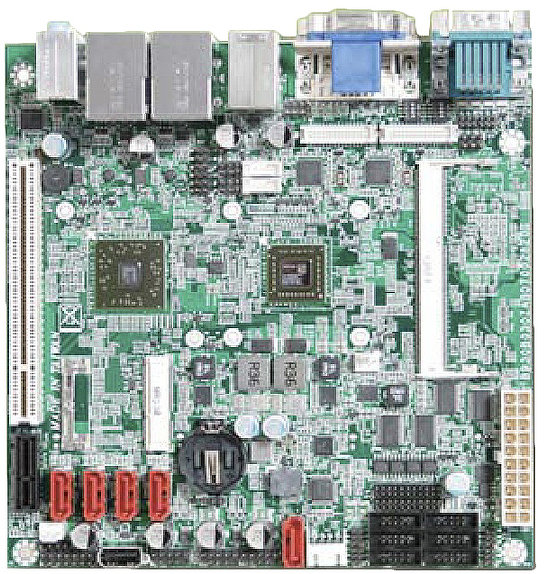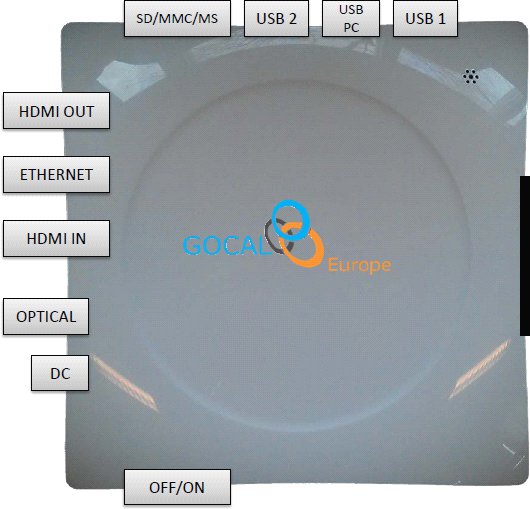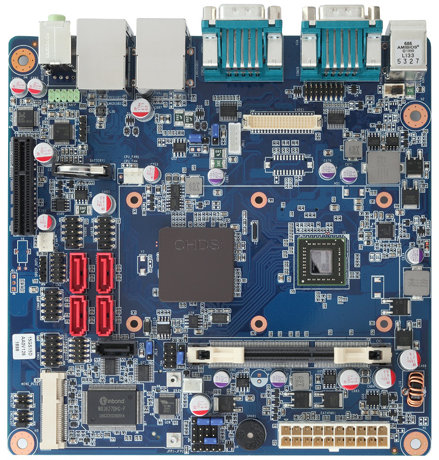Gumstix has just announced the Waysmall Silverlode computer, a small form factor device running Linaro ARM optimized Ubuntu and designed for developers of commercial and industrial applications such as digital signage players and remote servers. It’s based on Overo EarthSTORM Computer-on-Module (Texas Instruments Sitara AM3703 @ 1 GHz, 512MB Flash and 512MB RAM) and consumes less than 2.5 W. Here are the specs of the device: Processor Texas Instruments Sitara AM3703 processor (ARM Cortex-A8 ) @ 1 GHz 800 MHz is recommended for reliable performance System Memory 512 MB RAM Storage 512 MB NAND flash microSD card slot Video Output HDMI (DVI-D) Audio I/O Stereo Audio In /Out jacks Connectivity 10/100Mb Ethernet USB USB Host, USB OTG and USB Console Connectors 2 x 70-pin AVX connectors 1 x 27-pin Hirose camera connector Battery holder for 6mm rechargeable coin Dimensions 11.0 x 4 .4 x 1.8 cm Power 5V The computer […]
VIA Announces ARM Cortex A9 Based Digital Signage System
VIA has unveiled its ARM Digital Signage (DS) system for cost sensitive high volume digital signage deployments. The system is based on an unnamed Cortex A9 processor (possibly Wondermedia WM8850?) with up to 2 GB RAM and 64 GB Flash. The company expects the device to be used in a wide range of applications such as kiosks, POS systems, video walls, menu boards to TVOIP, cloud streaming, and Out of Home Advertising. Here are the specs of this digital signage player: All in one system-ready to load software Designed for Android operating system Industry standard ARM Cortex A9 SoC Hardware acceleration of the most demanding video formats for resolutions up to 1080p DVI-D display port (HDMI Optional) 4x USB 2.0 ports 10/100 Ethernet port Audio-out/ Mic-in Up to 64GB NAND Flash Up to 2GB DDR3 SDRAM Dimension – 18 cm x 12 cm x 2.5 cm The VIA ARM DS […]
Advantech RSB-4210: Freescale i.MX53 Single Board Computer
Advantech has just launched the RSB-4210, a fanless and heatsink-less RISC Single Board (RSB) powered by Freescale i.MX53 (Cortex A8) with 512 MB DDR3 and 2 GB NAND Flash. This board can operate in industrial temperature range (-40 to 85° C) and targets industrial control, digital signage, HMI/kiosk, medical, and portable applications. Here are the key features of this board: Freescale ARMCortex-A8 i.MX536 @ 800MHz Supports OpenGL ES 2.0 and OpenVG 1.1 hardware accelerators Supports full HD 1080p video decode and HD 720p hardware video encode Video Output LCD support with resolution up to 1920×1080 (default 800×480) via LVDS connector HDMI VGA Touch, UART, I2C, I2S, SPI, GPIO, USB Supports SATA storage interface and CAN-bus for vehicle applications Dimensions – 146 x 102 x 20 mm Power – 9 ~ 24 V DC with 3-watt power consumption Operating temperature – -40 ~ 85° C If you don’t mind about the […]
VIA Technologies Announces VIA AMOS-3002 System For Embedded Applications
VIA Technologies has just unveiled the VIA AMOS-3002, a fanless system based on VIA EPIA-P900 Pico-ITX board, targeting embedded applications such as telematics, in-vehicle control, machine to machine controller (M2M), digital signage and kiosks. The VIA EPIA-P900 Pico-ITX board is powered by VIA Eden X2 dual core processor (1GHz) together with VIA VX900H media system processor (MSP) and VIA Chrome 9 video processor which render VIA AMOS-3002 systems capable of handling hardware video decoding for MPEG-2, WMV9 and H.264 codecs at 1080p resolution. Two models are available: AMOS-3002-2D10A1 and AMOS-3002-2D10A1. The latter features a 2.5” SATA hard disk drive bay which is not available in AMOS-3002-2D101A1. Here are the specifications for both VIA AMOS-3002 Models: CPU – VIA Eden X2 @ 1.0GHz Chipset – VIA VX900H Media System Processor Memory – 1x DDR3 1066 204-pin SODIMM socket (Up to 4GB) Storage: 1x CFast Flash disk socket 1 x 2.5” SATA hard […]
Xibo Digital Signage Running on Mele A1000 AllWinner A10 Set-Top Box
Those following my blog know that I recently bought a Mele A1000 to play around. For those who are not familiar with this device, the Mele A1000 is a $70 Android set-top box featuring an AllWinner A10 cortex A8 processor and lots of peripherals, and it can easily be hacked to run a Linux distributions. This hardware would also be a great digital signage player thanks to its video playback capabilities: up to 2160p video decoding and 1080p video output. Last year, I ported Xibo, an open source digital signage player, to ARM and ran it in the Beagleboard emulator (qemu), but I hadn’t had the opportunity to try it out in a real hardware. I’ve tried this rootfs based on Linaro ARM Linux Internet Platform (ALIP) image for BeagleBoard in the Mele A1000, by following an adaptation of the method I provided earlier. For this demo, I created a […]
Portwell AMDY-7000 Series Mini-ITX Boards Based on AMD Embedded Processors
American Portwell Technology has announced the AMDY-7000 Series Mini-ITX embedded system boards targeting applications that require high quality graphics output with low power consumption such as digital signage, surveillance security monitoring, point of sales (PoS) and more. The company provides 3 families of AMDY-7000 series mini-ITX boards: AMDY-7000 – Single-core AMD Athlon II Neo R44L processor. AMDY-7001 – Dual-core AMD Turion II Neo N54H, AMD Athlon II Neo N36L or single-core AMD Athlon II Neo R44L processor. AMDY-7002 – Dual-core AMD Fusion G T56N processor. The AMDY-7000/7001/7002 Series models are powered by AMD Fusion processors featuring ATI HD 6320 and HD 4200 GPU. Depending upon the model, the power consumption ranges from a 12W to 25W. All boards can support up to 8GB DDR3 SO-DIMM memory, dual display via VGA/DVI/HDMI/LVDS and dual LVDS (AMDY-7002 only), PCIe x1, PCIe x16 or half-size mini-PCIe depending on the model and dual Gbit Ethernet. […]
Gocal Europe Android Digital Signage Players Based on AMLogic AML8726
Gocal Europe is a dutch company with offices in Shenzhen and Hong Kong providing OEM/ODM high tech solutions such as digital signage and Android TV solutions including players as well as software solutions via HelloTV. The company has 2 digital signage players running Android 4.0 (ICS): UFO-TV This player is based on AMLogic AML8726M3 and features 1GB RAM, 4GB flash, HDMI IN and HMDI OUT. Here are the device specifications: CPU – AMLogic AM8726 M3 (ARM Cortex A9) @ 1GHz with Mali-400 GPU System Memory – 1 GB Flash – 4 GB Video Container Formats – avi, mpeg, vob,mkv, ts, m2ts, wmv and rm Video Codecs – MPEG1, MPEG2, MPEG4, MPEG2-HD and VC-1. Audio Formats – MP3, WMA, WAV, MIDI, OGG, AC3, DTS, ACC and APE External Storage – SD, SDHC and MMC cards. USB – 2x USB 2.0 Host ports Connectivity – Ethernet 10/100 Mbps, WiFi and Bluetooth Video […]
Axiomtek MANO120 Mini-ITX Board Powered by AMD G-series APU
Axiomtek announced the MANO120 mini-ITX motherboard featuring an AMD G-Series APU dual core T56N with AMD A55E FCH which supports dual video output (dual views) via VGA, HDMI and LVDS interface. The board can support up to 4 GB of DDR3 1333 memory, up to 5 SATA hard drives and a CFast slot. The MANO120 also comes with one PCIe x4 slot and one PCI Express Mini Card slot. The company says the MANO120 industrial grade motherboard is ideal for digital signage, DVR (Digital Video Recording), and NVR (Network Video Recorder) applications. Here are Axiomtek MANO120 mini-ITX board specifications. CPU – AMD G-Series APU T56N @ 1.65 GHz with AMD Radeon HD6320 Graphic engine Chipset – AMD A55E FCH System Memory – 204-pin SO-DIMM supports DDR3-1066/1333 max (up to 4 GB) BIOS – AMI EFI 16Mb SPI SSD – CFast slot Expansion Interfaces: PCIe x4 slot PCIe Mini Card CFast […]


